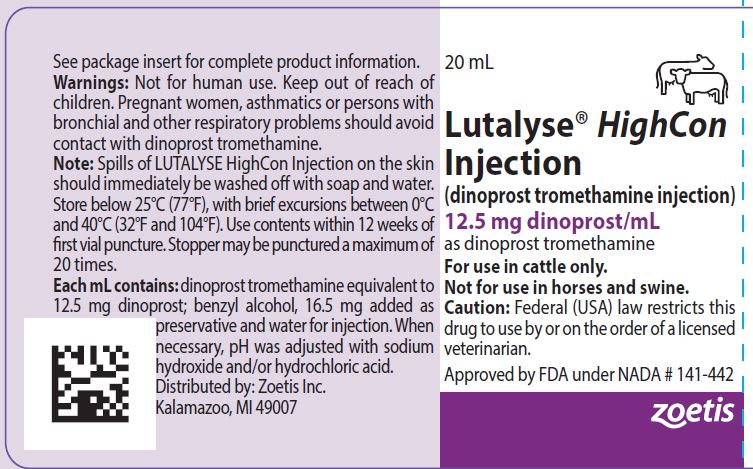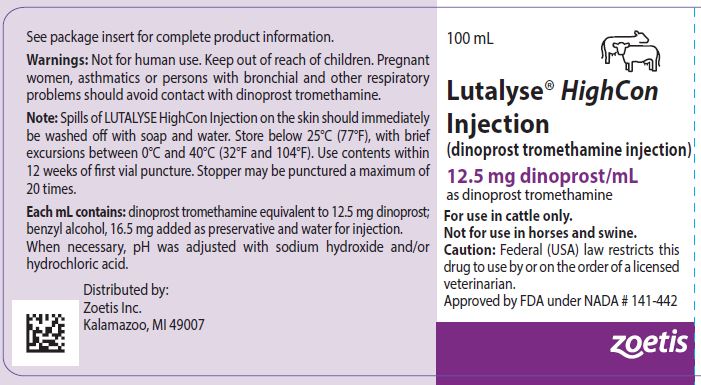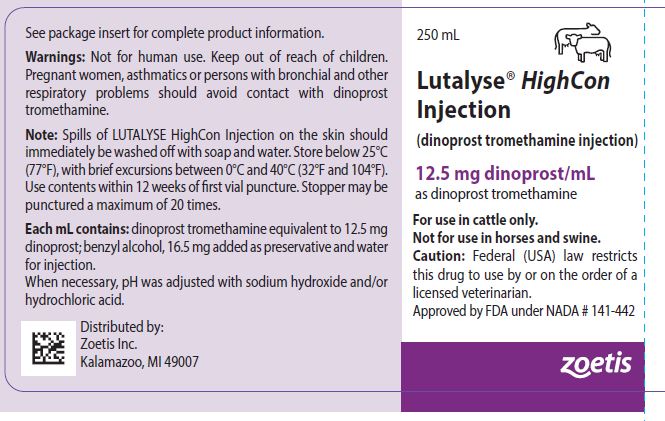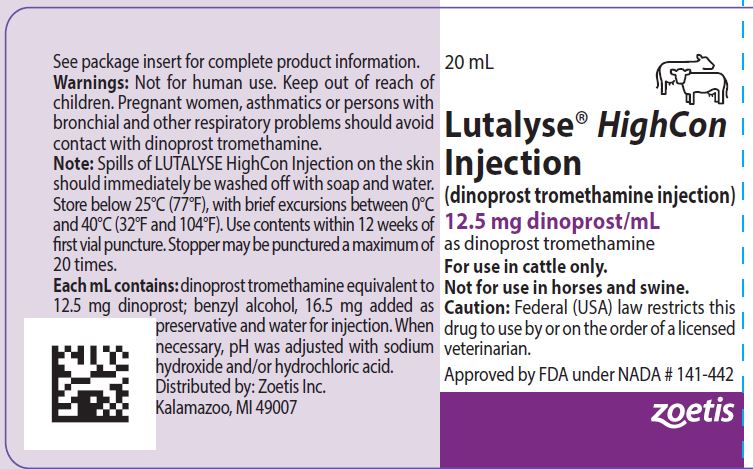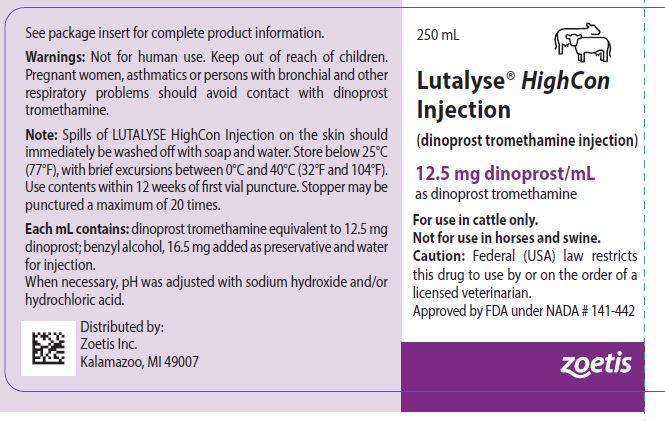Label: LUTALYSE HIGHCON STERILE- dinoprost tromethamine injection, solution
- NDC Code(s): 54771-1328-1, 54771-1328-2, 54771-1328-3
- Packager: Zoetis Inc.
- Category: PRESCRIPTION ANIMAL DRUG LABEL
- DEA Schedule: None
- Marketing Status: New Animal Drug Application
Drug Label Information
Updated October 8, 2021
If you are a consumer or patient please visit this version.
- Download DRUG LABEL INFO: PDF XML
- Official Label (Printer Friendly)
- SPL UNCLASSIFIED SECTION
-
DESCRIPTION
LUTALYSE® HighCon Injection (12.5 mg dinoprost/mL) is a sterile solution containing the naturally occurring prostaglandin F2 alpha (dinoprost) as the tromethamine salt. Each mL contains dinoprost tromethamine equivalent to 12.5 mg dinoprost: also, benzyl alcohol, 16.5 mg added as preservative and water for injection. When necessary, pH was adjusted with sodium hydroxide and/or hydrochloric acid. Dinoprost tromethamine is a white or slightly off-white crystalline powder that is readily soluble in water at room temperature in concentrations to at least 200 mg/mL.
-
INDICATIONS FOR USE
LUTALYSE HighCon Injection is indicated as a luteolytic agent. LUTALYSE HighCon Injection is effective only in those cattle having a corpus luteum, i.e., those which ovulated at least five days prior to treatment.
• For estrus synchronization in beef cows, beef heifers and replacement dairy heifers
• For unobserved (silent) estrus in lactating dairy cows with a corpus luteum
• For treatment of pyometra (chronic endometritis) in cattle
• For abortion in beef cows, beef heifers and replacement dairy heifers
• For use with FACTREL (gonadorelin injection) Injection to synchronize estrous cycles to allow fixed-time artificial insemination (FTAI) in lactating dairy cows
• For use with EAZI-BREED™ CIDR® (progesterone intravaginal insert) Cattle Insert for synchronization of estrus in lactating dairy cows
• For use with EAZI-BREED™ CIDR® (progesterone intravaginal insert) Cattle Insert for synchronization of estrus in suckled beef cows and replacement beef and dairy heifers, advancement of first postpartum estrus in suckled beef cows, and advancement of first pubertal estrus in beef heifers -
MANAGEMENT CONSIDERATIONS
Many factors contribute to success and failure of reproduction management, and these factors are important also when time of breeding is to be regulated with LUTALYSE HighCon Injection. Some of these factors are:
a. Cattle must be ready to breed—they must have a corpus luteum and be healthy;
b. Nutritional status must be adequate as this has a direct effect on conception and the initiation of estrus in heifers or return of estrous cycles in cows following calving;
c. Physical facilities must be adequate to allow cattle handling without being detrimental to the animal;
d. Estrus must be detected accurately if timed Al is not employed;
e. Semen of high fertility must be used;
f. Semen must be inseminated properly.A successful breeding program can employ LUTALYSE HighCon Injection effectively, but a poorly managed breeding program will continue to be poor when LUTALYSE HighCon Injection is employed unless other management deficiencies are remedied first. Cattle expressing estrus following LUTALYSE HighCon Injection are receptive to breeding by a bull. Using bulls to breed large numbers of cattle in heat following LUTALYSE HighCon Injection will require proper management of bulls and cattle. Future reproductive performance of animals that are not cycling will be unaffected by injection of LUTALYSE HighCon Injection.
-
DOSAGE AND ADMINISTRATION
As with any multi-dose vial, practice aseptic techniques in withdrawing each dose to decrease the possibility of post- injection bacterial infections. Adequately clean and disinfect the vial stopper prior to entry with a sterile needle and syringe. Use only sterile needles, and use each needle only once. No vial stopper should be entered more than 20 times.
1. For Estrus Synchronization in Beef Cows, Beef Heifers and Replacement Dairy Heifers. LUTALYSE HighCon Injection is used to control the timing of estrus and ovulation in estrous cycling cattle that have a corpus luteum. Inject a dose of 2 mL LUTALYSE HighCon Injection (25 mg dinoprost) intramuscularly or subcutaneously either once or twice at a 10 to 12 day interval. With the single injection, cattle should be bred at the usual time relative to estrus. With the two injections cattle can be bred after the second injection either at the usual time relative to detected estrus or at about 80 hours after the second injection of LUTALYSE HighCon Injection. Estrus is expected to occur 1 to 5 days after injection if a corpus luteum was present. Cattle that do not become pregnant to breeding at estrus on days 1 to 5 after injection will be expected to return to estrus in about 18 to 24 days.
2. For Unobserved (Silent) Estrus in Lactating Dairy Cows with a Corpus Luteum. Inject a dose of 2 mL LUTALYSE HighCon Injection (25 mg dinoprost) by intramuscular or subcutaneous injection. Breed cows as they are detected in estrus. If estrus has not been observed by 80 hours after injection, breed at 80 hours. If the cow returns to estrus, breed at the usual breed at the usual time relative to estrus.
3. For Treatment of Pyometra (chronic endometritis) in Cattle. Inject a dose of 2 mL LUTALYSE HighCon Injection (25 mg dinoprost) by intramuscular or subcutaneous injection.
4. For Abortion in Beef Cows, Beef Heifers and Replacement Dairy Heifers. LUTALYSE HighCon Injection is indicated for its abortifacient effect in beef cows, beef heifers and replacement dairy heifers during the first 100 days of gestation. Inject a dose of 2 mL LUTALYSE HighCon Injection (25 mg dinoprost) by intramuscular or subcutaneous injection. Cattle that abort will abort within 35 days of injection.
5. For use with FACTREL® (gonadorelin injection) Injection to synchronize estrous cycles to allow fixed-time artificial insemination (FTAI) in lactating dairy cows: Administer 2 to 4 mL FACTREL Injection (100-200 mcg gonadorelin) per cow as an intramuscular injection in a treatment regimen with the following framework:
• Administer the first dose of FACTREL Injection (2-4 mL) at Day 0
• Administer a dose of 2 mL LUTALYSE HighCon Injection (25 mg dinoprost) by intramuscular or subcutaneous injection 6-8 days after the first dose of FACTREL Injection.
• Administer a second dose of FACTREL Injection (2-4 mL) 30 to 72 hours after the LUTALYSE HighCon Injection.
• Perform FTAI 0 to 24 hours after the second dose of FACTREL Injection, or inseminate cows on detected estrus using standard herd practices.Below are three examples of treatment regimens for the dosage regimen framework described immediately above:
Example 1
Example 2
Example 3
Day 0 (Monday)
1st Factrel
1st Factrel
1st Factrel
Day 7 (the following Monday)
LUTALYSE
HighCon
LUTALYSE
HighCon
LUTALYSE
HighCon
Day 9 (Wednesday)
2nd Factrel
+ FTAI at 48 hours
after
LUTALYSE
HighCon
2nd Factrel
at 48 hours
after
LUTALYSE
HighCon
2nd Factrel
at 56 hours
after
LUTALYSE
HighCon
Day 10 (Thursday)
FTAI
24 hours
after 2nd FACTREL
FTAI
18 hours
after 2nd FACTREL
6. For use with EAZI-BREED™ CIDR® (progesterone intravaginal insert) Cattle Insert for Synchronization of Estrus in Lactating Dairy Cows:
• Administer one EAZI-BREED CIDR Cattle Insert per animal and remove 7 days later (for example if administered on a Monday remove the following Monday).
• Administer a dose of 2 mL LUTALYSE HighCon Injection (25 mg dinoprost) by intramuscular subcutaneous injection at the time of removal of the EAZI-BREED CIDR Cattle Insert.
• Observe animals for signs of estrus on Days 2 to 5 after removal of the EAZI-BREED CIDR Cattle Insert and inseminate animals found in estrus following normal herd practices.7. For use with EAZI-BREED™ CIDR® (progesterone intravaginal insert) Cattle Insert for synchronization of estrus in suckled beef cows and replacement beef and dairy heifers, advancement of first postpartum estrus in suckled beef cows, and advancement of first pubertal estrus in beef heifers:
• Administer one EAZI-BREED CIDR Cattle Insert per animal for 7 days (for example, if administered on a Monday remove on the following Monday).
• Administer a dose of 2 mL LUTALYSE HighCon Injection (25 mg dinoprost) by intramuscular or subcutaneous injection 1 day prior to EAZI-BREED CIDR Cattle Insert removal, on Day 6 of the 7 day administration period.
• Observe animals for signs of estrus on Days 1 to 3 after removal of the EAZI-BREED CIDR Cattle Insert and inseminate animals about 12 hours after onset of estrus.
-
WARNINGS AND PRECAUTIONS
User Safety: Not for human use. Keep out of the reach of children. Women of childbearing age, asthmatics, and persons with bronchial and other respiratory problems should exercise extreme caution when handling this product. In the early stages, women may be unaware of their pregnancies. Dinoprost tromethamine is readily absorbed through the skin and can cause abortion and/or bronchiospasms. Accidental spillage on the skin should be washed off immediately with soap and water.
Residue Warnings: No milk discard or preslaughter drug withdrawal period is required for labeled uses in cattle. Use of this product in excess of the approved dose may result in drug residues.
Animal Safety Warnings: Severe localized clostridial infections associated with injection of LUTALYSE Injection have been reported. In rare instances, such infections have resulted in death. Aggressive antibiotic therapy should be employed at the first sign of infection at the injection site whether localized or diffuse. Do not administer intravenously (IV) as this route may potentiate adverse reactions. Nonsteroidal anti-inflammatory drugs may inhibit prostaglandin synthesis; therefore this class of drugs should not be administered concurrently. Do not administer to pregnant cattle, unless abortion is desired. Cattle administered a progestin would be expected to have a reduced response to LUTALYSE Injection. - ADVERSE REACTIONS
- CONTACT INFORMATION
-
CLINICAL PHARMACOLOGY
General Biologic Activity: Prostaglandins occur in nearly all mammalian tissues. Prostaglandins, especially PGE’s and PGF’s, have been shown, in certain species, to 1) increase at time of parturition in amniotic fluid, maternal placenta, myometrium, and blood, 2) stimulate myometrial activity, and 3) to induce either abortion or parturition. Prostaglandins, especially PGF2α, have been shown to 1) increase in the uterus and blood to levels similar to levels achieved by exogenous administration which elicited luteolysis, 2) be capable of crossing from the uterine vein to the ovarian artery (sheep), 3) be related to IUD induced luteal regression (sheep), and 4) be capable of regressing the corpus luteum of most mammalian species studied to date. Prostaglandins have been reported to result in release of pituitary tropic hormones. Data suggest prostaglandins, especially PGE’s and PGF’s, may be involved in the process of ovulation and gamete transport. Also PGF2α has been reported to cause increase in blood pressure, bronchoconstriction, and smooth muscle stimulation in certain species.
Metabolism: A number of metabolism studies have been done in laboratory animals. The metabolism of tritium labeled dinoprost (3H PGF2 alpha) in the rat and in the monkey was similar. Although quantitative differences were observed, qualitatively similar metabolites were produced. A study demonstrated that equimolar doses of 3H PGF2 alpha Tham and 3H PGF2 alpha free acid administered intravenously to rats demonstrated no significant differences in blood concentration of dinoprost. An interesting observation in the above study was that the radioactive dose of 3H PGF2 alpha rapidly distributed in tissues and dissipated in tissues with almost the same curve as it did in the serum. The half-life of dinoprost in bovine blood has been reported to be on the order of minutes. A complete study on the distribution of decline of 3H PGF2 alpha Tham in the tissue of rats was well correlated with thework done in the cow. Cattle serum collected during 24 hours after doses of 0 to 250 mg dinoprost have been assayed by RIA for dinoprost and the 15-keto metabolites. These data support previous reports that dinoprost has a half-life of minutes. Dinoprost is a natural prostaglandin. All systems associated with dinoprost metabolism exist in the body; therefore, no new metabolic, transport, excretory, binding or other systems need be established by the body to metabolize injected dinoprost.
Relative Bioavailability Study: The requirement for substantial evidence of effectiveness was fulfilled by a pharmacokinetic study comparing the relative bioavailability of the subcutaneous (SC) administration of 25 mg of LUTALYSE HighCon Injection (12.5 mg dinoprost/mL) to the approved intramuscular (IM) administration of 25 mg of LUTALYSE Injection (5 mg dinoprost/mL). The effectiveness data for LUTALYSE Injection at doses of 25 and 35 mg IM were used to support an adjusted Test/Reference (T/R) ratio of 1.4 and 90% Confidence Intervals of 80 - 164% for Cmax and AUC to demonstrate therapeutic equivalence.
The pivotal relative bioavailability study was a randomized, non-replicated, three treatment, three period, six sequence crossover study in 24 cows (4 cows per sequence). Each cow received a single dose of 25 mg dinoprost administered as 5 mL of LUTALYSE Injection IM, 5 mL of LUTALYSE Injection SC, or 2 mL of LUTALYSE HighCon SC, with a washout period of 48 hours between doses. Plasma samples were collected at 60 and 10 minutes prior to dose administration, and at 5, 10, 15, 20, 30, 75 minutes, and at 2, 3, 4.5, 6, 7.5, and 12 hours after each dose. Samples were analyzed by UPLC-MS/MS for PGF2α (dinoprost) and PGFm (metabolite) concentrations. PGFm was chosen as the analyte of interest because its concentrations are reflective of exogenously administered dinoprost (after subtraction of endogenous concentrations), and it has a longer half-life and therefore less blood level fluctuations than PGF2α. The results of the relative bioavailability study are summarized in Table 1. The Cmax and AUClast of LUTALYSE HighCon were within the adjusted 90% Confidence Intervals. Therefore, the SC administration of 25 mg of LUTALYSE HighCon was equivalent to the IM administration of 25 mg LUTALYSE Injection.
Table 1: Relative Bioavailability Results for LUTALYSE HighCon Injection
Parameter
Product/
Route
LSMean
Ratio
T/ R†
Lower
90% CI
Upper
90% CI
Cmax
(ng/mL)
LUTALYSE
Injection
(IM)*
41.26
LUTALYSE
Injection
(SC)*
50.80
1.23
110.99
136.60
LUTALYSE
HighCon
Injection
(SC)
55.12
1.34
120.42
148.20
AUClast) (hr*ng/mL)
LUTALYSE
Injection
(IM)*
66.85
LUTALYSE
Injection
(SC)
67.25
1.00
96.26
105.12
LUTALYSE
HighCon Injection
(SC)
65.81
0.98
94.20
102.87
Cmax - maximum plasma concentration
AUClast - the area under the plasma concentration vs. time curve from time of injection to the limit of quantification of the assay
* Reference product and route of administration
† Geometric means
-
TARGET ANIMAL SAFETY
TARGET ANIMAL SAFETY
Laboratory Animals: Dinoprost was non-teratogenic in rats when administered orally at 1.25, 3.2, 10.0 and 20.0 mg dinoprost/kg/day from day 6th-15th of gestation or when administered subcutaneously at 0.5 and 1.0 mg/kg/day on gestation days 6, 7 and 8 or 9, 10 and 11 or 12, 13 and 14. Dinoprost was non-teratogenic in the rabbit when administered either subcutaneously at doses of 0.5 and 1.0 mg dinoprost/kg/day on gestation days 6, 7 and 8 or 9, 10 and 11 or 12, 13 and 14 or 15, 16 and 17 or orally at doses of 0.01, 0.1 and 1.0 mg dinoprost/kg/day on days 6-18 or 5.0 mg/kg/day on days 8-18 of gestation. A slight and marked embryo lethal effect was observed in dams given 1.0 and 5.0 mg dinoprost/kg/day respectively. This was due to the expected luteolytic properties of the drug.
A 14-day continuous intravenous infusion study in rats at 20 mg PGF2α per kg body weight indicated prostaglandins of the F series could induce bone deposition. However, such bone changes were not observed in monkeys similarly administered 15 mg dinoprost per kg body weight for 14 days.
Cattle: In cattle, evaluation was made of clinical observations, clinical chemistry, hematology, urinalysis, organ weights, and gross plus microscopic measurements following treatment with various doses up to 250 mg dinoprost administered twice intramuscularly at a 10 day interval or doses of 25 mg administered daily for 10 days. There was no unequivocal effect of dinoprost on the hematology or clinical chemistry parameters measured. Clinically, a slight transitory increase in heart rate was detected. Rectal temperature was elevated about 1.5˚ F through the 6th hour after injection with 250 mg dinoprost, but had returned to baseline at 24 hours after injection. No dinoprost associated gross lesions were detected. There was no evidence of toxicological effects. Thus, dinoprost had a safety factor of at least 10X on injection (25 mg luteolytic dose vs. 250 mg safe dose), based on studies conducted with cattle. At luteolytic doses, dinoprost had no effect on progeny. If given to a pregnant cow, it may cause abortion; the dose required for abortion varies considerably with the stage of gestation. Induction of abortion in feedlot cattle at stages of gestation up to 100 days of gestation did not result in dystocia, retained placenta or death of heifers in the field studies. The smallness of the fetus at this early stage of gestation should not lead to complications at abortion. However, induction of parturition or abortion with any exogenous compound may precipitate dystocia, fetal death, retained placenta and/or metritis, especially at latter stages of gestation.
Injection Site Safety Summary: Eight non-lactating, non-pregnant dairy cows were injected with saline and eight animals were injected with LUTALYSE HighCon (12.5 mg dinoprost/mL @ 25 mg/animal) twice, at an interval of ten days. The first injection was administered in the left neck on Day 0 and the second injection was administered in the right neck on Day 10. Clinical observations were conducted on Days -14, -1, 0, 1, 2, 10, and 11, and injection site observations were conducted on all animals once on Days -14, -1, and once daily from Day 0 until Day 11. Animals were euthanized on Day 11. There were no abnormal clinical observations or general health observations related to drug administration during the conduct of the study. Injection site observations revealed no findings of erythema, heat, or sensitivity. No hardness was noted at the injection sites in any control animal post treatment administration. In the treated group, two animals had hardness noted on the right neck on Day 11. This hardness was probably a result of test article administration at that site on the previous day. No abnormal skin appearance was noted in any animal during this study. Swelling with a volume of 3.53 cm3 was observed on Day 11 in the right neck in one treated animal. At necropsy discoloration (variations of dark red, tan, gray, or yellow mottled) in the subcutaneous tissue was observed at all dinoprost injection sites. More discolored subcutaneous tissue was present at the Day 10 injection sites compared to the Day 0 injection sites. There was no discoloration observed in the deep muscle tissue. In summary, this study demonstrated that subcutaneous injection of LUTALYSE HighCon was well tolerated when injected subcutaneously into dairy cows at a dose of 25 mg dinoprost/cow twice at an interval of 10 days.
-
EFFECTIVENESS
The requirement for substantial evidence of effectiveness was fulfilled by a pharmacokinetic study comparing the relative bioavailability of the SC administration of 25 mg of LUTALYSE HighCon Injection (12.5 mg dinoprost/mL) to the approved IM administration of 25 mg of LUTALYSE Injection (5 mg dinoprost/ mL) (see CLINICAL PHARMACOLOGY, Relative Bioavailability Study). This study demonstrated the equivalence of the SC administration of 25 mg of LUTALYSE HighCon to the IM administration of 25 mg of LUTALYSE Injection. Therefore, the effectiveness studies conducted with LUTALYSE Injection support the effectiveness of LUTALYSE HighCon Injection.
For Treatment of Pyometra (chronic endometritis) in Cattle: In studies conducted with LUTALYSE Injection, pyometra was defined as presence of a corpus luteum in the ovary and uterine horns containing fluid but not a conceptus based on palpation per rectum. Return to normal was defined as evacuation of fluid and return of the uterine horn size to 40mm or less based on palpation per rectum at 14 and 28 days. Most cattle that recovered in response to LUTALYSE Injection recovered within 14 days after injection. After 14 days, recovery rate of treated cattle was no different than that of non-treated cattle.
For Abortion in Beef Cows, Beef Heifers and Replacement Dairy Heifers: Commercial cattle were palpated per rectum for pregnancy in six feedlots. The percent of pregnant cattle in each feedlot less than 100 days of gestation ranged between 26 and 84; 80% or more of the pregnant cattle were less than 150 days of gestation. The abortion rates following injection of LUTALYSE Injection increased with increasing doses up to about 25 mg. As examples, the abortion rates, over 7 feedlots on the dose titration study, were 22%, 50%, 71%, 90% and 78% for cattle up to 100 days of gestation when injected IM with LUTALYSE Injection doses of 0, 1 (5 mg), 2 (10 mg), 4 (20 mg) and 8 (40 mg) mL, respectively. The statistical predicted relative abortion rate based on the dose titration data was about 93% for the 5 mL (25 mg) LUTALYSE Injection dose for cattle injected up to 100 days of gestation.
For use with FACTREL® (gonadorelin injection) Injection to synchronize estrous cycles to allow fixed-time artificial insemination (FTAI) in lactating dairy cows: For a full description of the studies conducted for the use of FACTREL Injection and LUTALYSE Injection, please refer to the labeling for FACTREL Injection.
- HOW SUPPLIED
- STORAGE, HANDLING AND DISPOSAL
- SPL UNCLASSIFIED SECTION
- PRINCIPAL DISPLAY PANEL - 20 mL Label
- PRINCIPAL DISPLAY PANEL - 100 mL Label
- PRINCIPAL DISPLAY PANEL - 250 mL Label
-
INGREDIENTS AND APPEARANCE
LUTALYSE HIGHCON STERILE
dinoprost tromethamine injection, solutionProduct Information Product Type PRESCRIPTION ANIMAL DRUG Item Code (Source) NDC:54771-1328 Route of Administration INTRAMUSCULAR Active Ingredient/Active Moiety Ingredient Name Basis of Strength Strength DINOPROST TROMETHAMINE (UNII: CT6BBQ5A68) (DINOPROST - UNII:B7IN85G1HY) DINOPROST 12.5 mg in 1 mL Inactive Ingredients Ingredient Name Strength BENZYL ALCOHOL (UNII: LKG8494WBH) 16.5 mg in 1 mL SODIUM HYDROXIDE (UNII: 55X04QC32I) HYDROCHLORIC ACID (UNII: QTT17582CB) Packaging # Item Code Package Description Marketing Start Date Marketing End Date 1 NDC:54771-1328-1 20 mL in 1 VIAL 2 NDC:54771-1328-2 100 mL in 1 VIAL 3 NDC:54771-1328-3 250 mL in 1 VIAL Marketing Information Marketing Category Application Number or Monograph Citation Marketing Start Date Marketing End Date NADA NADA141442 11/02/2015 Labeler - Zoetis Inc. (828851555)

